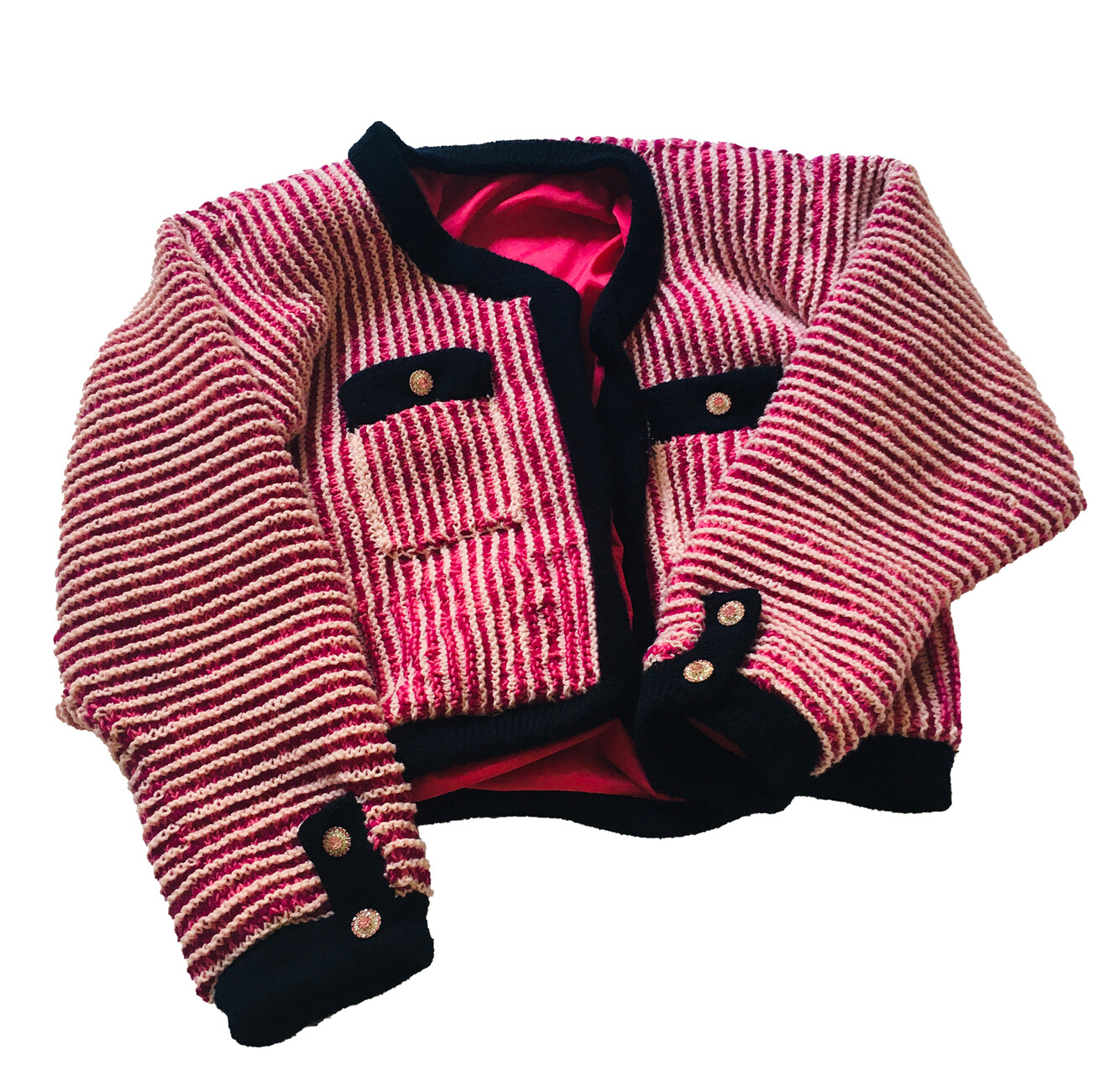YOUNG TALENTS
Transparency of Origins
Anna Moldenhauer: What makes the textile industry interesting to you?
Xenia Watson: My interest in the textile industry came about somewhat by chance. On the one hand, the issue of sustainability is integrated into the design processes at the Offenbach University of Art and Design as a matter of course. For example, we always discuss the advantages and disadvantages of our chosen materials and what alternatives are available. On the other hand, I had more time to knit during the pandemic as a result of which I was able to explore the wide range and also the quality differences in yarns. Simply in terms of their haptic properties, there is a noticeable difference between hand-knitted items of clothing and those sold in the large fashion chains. Another aspect is the price: when I knitted a mohair wool sweater myself, the cost of the materials alone came to around 350 euros, which of course did not include my labor. I was also amazed at the large amount of material needed to make the garment. In fast fashion, synthetic yarn is used extensively to keep down the cost. Here, too, the question of sourcing arises. Once you’ve become aware of these aspects, you start to think about the details of the processes involved.
You developed the project “Within - A Shadow in Knitwear”, a shadow knit that is shot through with codes. These reveal, for example, how many kilometers the wool has traveled from its place of origin. What criteria did you use to select the codes?
Xenia Watson: My project is just one approach – the focus on the material can be expanded still further, for example by examining where the metal for the button comes from. I was amazed at how far materials travel before they are processed. Even labels that would be classified as “sustainable” actually source their wool from regions such as Peru, for example. The long transport routes put a damper on the claim of holistic sustainability. With the codes I also wanted to make it clear what it is you’re in fact wearing, because the label alone isn’t particularly informative. What exactly is acrylic? What do “Made in China” or “Made in Bangladesh” really mean? The process is anonymous to a large extent. Moreover, manual labor is appreciated in the case of customized clothing, but treated as a problem when it comes to mass production. We must develop a better sense of the effort that goes into a piece of clothing, even if it only costs five euros – from the treatment of the material to the work of the seamstresses and the logistics. In addition, many of the workers receive a wage that is well below the subsistence level or the cost of living in their respective countries. They work 14-hour shifts, six to seven days a week, and have no health insurance. And even production in Europe is not necessarily always better, because even here, low-wage workers are brought in from other countries. Even if you buy “designer clothes” from luxury brands it is no guarantee that the people who make these clothes are treated as real individuals or that it is possible to transparently trace where the materials are sourced. The textile industry as a whole is one of the most polluting industries in the world, and this is especially true of the fashion industry.
How did you find out where the material you used for the cardigan came from?
Xenia Watson: With yarns for home-knitting it is easier to find out the provenance, because the quantities are smaller, and the manufacturers usually have a greater interest in offering good quality from local makers. This is why the origin of the material is often indicated and the supply chains are also relatively transparent. Swiss manufacturer Langyarn, for example, runs an initiative called “trace your yarn”. This allows you to determine the origin of the wool quite precisely via the article number or name. Apart from that, you also learn interesting details in conversation with the vendors in wool supply stores, for example Atelier Zitron cooperates with a family business in Tasmania that works with merino sheep that have been bred back. These sheep no longer develop the skin folds that have previously been created by over-breeding the animals in order to obtain as much wool per sheep as possible. The latter practice results in animal suffering, because in order to avoid maggot infestation in the skin folds, farmers cut these folds off in the lambs’ and sheep’s rump area, usually without anesthesia, in a process called “mulesing”.
In your opinion, ought there to be a statutory requirement that any person be able to access the product-related data on their clothing, such as they can in the form of your codes?
Xenia Watson: The codes I knitted in are effectively a product code. I could well imagine that they could be a stylish fashion feature of sorts. An example of what I would like to see from the government, and what I was seeking to establish in the course of my research, is a universally applicable categorization of materials. Large textile companies source their materials from many places, so it is not easy to find out where the wool comes from. The information behind the codes should include how the material was then processed because processing methods such as for instance “SuperWash” change the state of the material such that the wool may no longer be biodegradable afterwards. Customers who care about what they buy could then identify what goes into the respective garment. The lack of transparency that we has persisted in the textile industry to date is simply no longer in keeping with the times.
Do you think it could motivate companies to set a positive example if consumers increasingly called for this level of transparency?
Xenia Watson: I see no reason why a company would refuse to meet a major demand. The fashion industry, for example, does not currently have to state that a garment is made in Bangladesh, but it is still common practice to produce there, and most customers know what this means in terms of manufacturing conditions.
Over and above that, what do you think it’s about?
Xenia Watson: It’s also about appreciation. There’s nothing wrong with owning a product that has traveled twice around the world. But you should be aware of it when you buy a garment that has traveled 30,000 kilometers. This applies not only to wool, but also to acrylic and other materials. Because even if those are cheaper, it doesn’t mean that you can throw them away without a thought. Every material is super valuable, especially in times of resource scarcity.
“Within - A Shadow in Knitwear” was your term project. What are your next steps?
Xenia Watson: I am very interested in the issue of textiles, if only in terms of the wide range of processing options. The development of greater transparency in the textile industry is a matter that is very close to my heart. The managers who are responsible can also expect to receive inquiries from consumers regarding production in our day and age. It should be part of the manufacturers’ corporate identity to be able to provide these answers even before animal and environmental protection organizations such as PETA or Greenpeace draw attention to them. Many paths led me to these organizations in the course of my research on the subject of wool. I don’t think secrecy is justified at this point. Customers must be informed about the provenance of their clothing. Sometimes a glance at the price is enough to make you wonder: If you know what a ball of cashmere wool costs, a cardigan made of this material can’t cost under 200 euros without people, animals and the environment having had to suffer during production.






